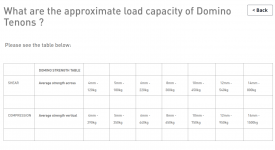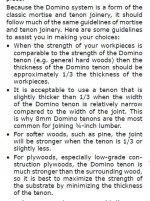smorgasbord
Member
EnCurtis has a video on making a shouldered domino joint:
It's a bit involved, requiring a jig to accurately cut the domino mortise in a dado, and then being able to cut the matching mortise in the true center of the end of the cross-piece.
The jig has a thickness, naturally, and so one has to compensate when setting the depth on the domino. And dado, too.
Matter of fact, he messed it up on his most recent video:=shared
And had to resort to making decorative mortise end fillers since he blew through the sides of his bookcase.
I get why shouldering the joint makes it stronger than just dominos. My question is under what circumstances is this additional strength needed/worth the effort?
I also think his jig would be better with the bushing option, as that would enable use of other diameter router bits to cut the dado, but I guess he's happy always doing ½" wide dados and cutting the shoulders as deep/shallow as necessary to have a ½" tenon (which he mills after cutting the domino mortises).
If you haven't watched either of these, watch the second one first, where he summarizes the jig and yet messes up. I like how honest he was about the mess-up and his solution, but again I'm wondering about whether I want to consider putting this into my joint repertoire. And if so, what better ways are there to machine it (using a Domino, of course).
It's a bit involved, requiring a jig to accurately cut the domino mortise in a dado, and then being able to cut the matching mortise in the true center of the end of the cross-piece.
The jig has a thickness, naturally, and so one has to compensate when setting the depth on the domino. And dado, too.
Matter of fact, he messed it up on his most recent video:=shared
And had to resort to making decorative mortise end fillers since he blew through the sides of his bookcase.
I get why shouldering the joint makes it stronger than just dominos. My question is under what circumstances is this additional strength needed/worth the effort?
I also think his jig would be better with the bushing option, as that would enable use of other diameter router bits to cut the dado, but I guess he's happy always doing ½" wide dados and cutting the shoulders as deep/shallow as necessary to have a ½" tenon (which he mills after cutting the domino mortises).
If you haven't watched either of these, watch the second one first, where he summarizes the jig and yet messes up. I like how honest he was about the mess-up and his solution, but again I'm wondering about whether I want to consider putting this into my joint repertoire. And if so, what better ways are there to machine it (using a Domino, of course).


